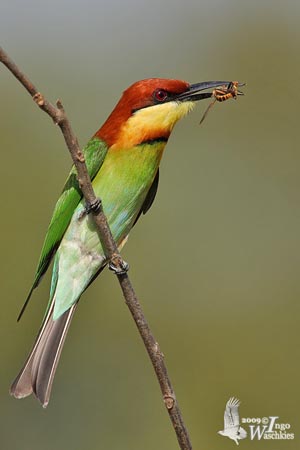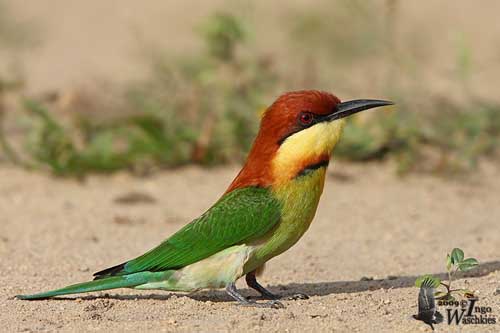
Fr: Guêpier de Leschenault
All : Braunkopfspint
Esp: Abejaruco Cabecirrufo
Ital: Gruccione testacastana di Leschenault
Nd: Bruinkopbijeneter
Sd: Rostbiätare
Photographers:
John Anderson
John Anderson Photo Galleries
Ingo Waschkies
Bird Photography
Text by Nicole Bouglouan
Sources:
HANDBOOK OF THE BIRDS OF THE WORLD Vol 6 by Josep del Hoyo-Andrew Elliott-Jordi Sargatal - Lynx Edicions, 2001 - ISBN: 848733430X
A Field Guide to the Birds of South-East Asia by Craig Robson. New Holland Publishers. ISBN: 9781780090498
L’ENCYCLOPEDIE MONDIALE DES OISEAUX - Dr Christopher M. Perrins - BORDAS - ISBN: 2040185607
BirdLife International (BirdLife International)
Wikipedia, the free encyclopaedia
Chestnut-headed Bee-eater
Merops leschenaulti
Coraciforme Order – Meropidae Family
INTRODUCTION:
The Chestnut-headed Bee-eater is a brightly coloured bird, like all bee-eaters, but it lacks the pair of elongated tail-streamers.
The scientific name “leschenaulti” pays tribute to the French botanist and ornithologist Jean Baptiste Leschenault de la Tour.
DESCRIPTION OF THE BIRD:
Biometrics:
Length: 20 cm
Weight: 23-33 g
The adult of nominate race has bright chestnut-brown crown and mantle. The wings are green with broad black band on the trailing edge, more conspicuous in flight. The rump is azure to pale turquoise. The tail is green with bluish tip. The central pair of rectrices is greener than other uppertail feathers, but this species lacks the elongated tail-streamers.
The underparts, chin, cheeks and throat are yellow, whereas the lower throat is rufous. A narrow, black gorget is visible along the lower throat’s border. The upperbreast is yellow, turning green in lower breast. The belly is blue-green, turning bluer on the undertail-coverts. The underwing is pale chestnut-brown with black trailing edge.
On the chestnut-brown head, we can see a black mask formed by black lores and eye stripe (below the eye).
The down-curved, pointed bill is black. The eyes are red, surrounded by black eyering. Legs and feet are blue-grey.

Both sexes are similar.
The juvenile has green crown and mantle, and variable amount of dull chestnut on the nape. The underparts are paler with pale dull chestnut on lower throat and indistinct bluish-green gorget.
SUBSPECIES AND RANGE:
The Chestnut-headed Bee-eater has three subspecies.
M.l. leschenaulti (here described and displayed) is found in S India and Sri Lanka, N India and Nepal E to SC China (Yunnan) and Indochina and Malay Peninsula.
M.l. andamanensis occurs on Andaman Islands and nearly islands of Great and Little Coco. This race is larger than nominate, with reduced mask and rufous breast sides.
M.l. quinticolor is found in Java and Bali, W into S Sumatra. This one has mostly chestnut mask and yellow lower throat.
HABITAT:
The Chestnut-headed Bee-eater is found at forest edges and in clearings, and in open areas in forested country, large gardens, coastal scrub, along riversides and roadsides, and sometimes in plantations. This species is visible up to 1800 metres of elevation.
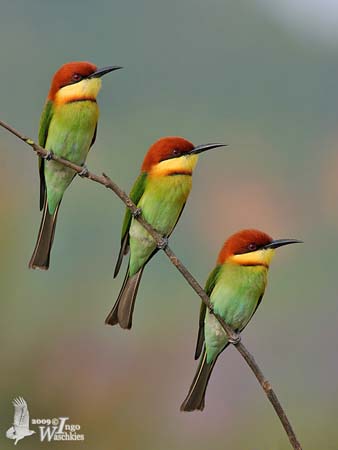
CALLS AND SONGS: SOUNDS BY XENO-CANTO
The Chestnut-headed Bee-eater utters a soft, airy “chewy-chewy-chewy” when perched. In flight, it gives a repeated soft bubbling “prruuip”, “pruik”, “churit” or djewy”.
BEHAVIOUR IN THE WILD:
The Chestnut-headed Bee-eater feeds on insects, and especially honeybees (Apis), wasps, ants, termites, dragonflies, butterflies and grasshoppers, some of them caught in flight by sally from an exposed perch.
The bird performs flycatching from top of bushes, bare branch or wires and fences. But they may also hunt in groups by wheeling flight, and catching insect after insect without returning to the perch.
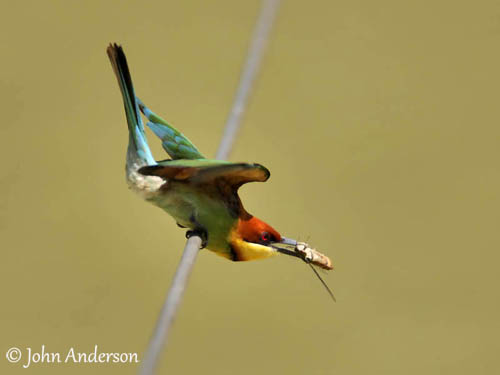
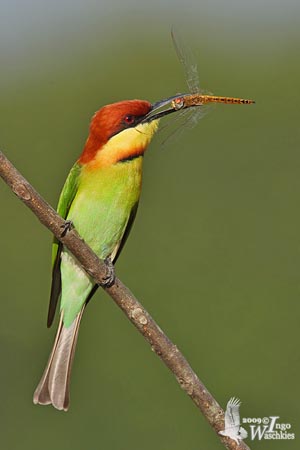
Usually, the bird flies directly at the prey and seizes it with the bill pointed forwards. But the Chestnut-headed Bee-eater has been seen splashing down into the water, and this behaviour is poorly understood. However, from several observations, bee-eaters could catch small fish on such occasions, or at least aquatic insects. But this behaviour probably refers to bathing too.
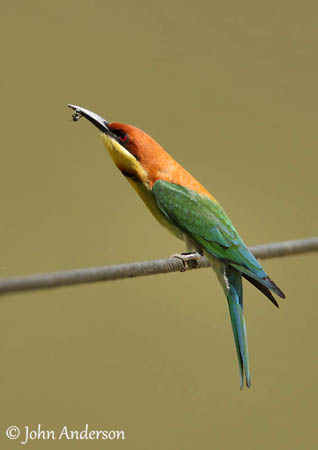
The Chestnut-headed Bee-eater nests in holes in earth or sand, and both sexes excavate their own tunnel. These bright-coloured birds have not spectacular courtship behaviour in spite of their rich and coloured plumage pattern.
However, they become more vocal, and their vocalizations are accompanied by rising of crown and throat feathers, spreading and quivering of tail and wing-rising. Courtship feeding is very common too.
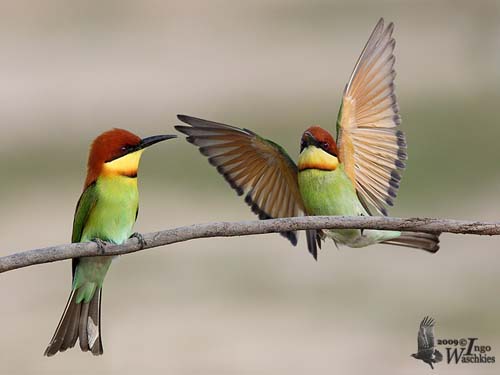
They also perform aerial displays, a butterfly-like flight including glides with wings hold high over the back, interspersed with shallow wingbeats and accompanied by calls.
Other displays show male and female perching and facing each other with raised wings. Then, they close the wings and bob up and down prior to copulation.
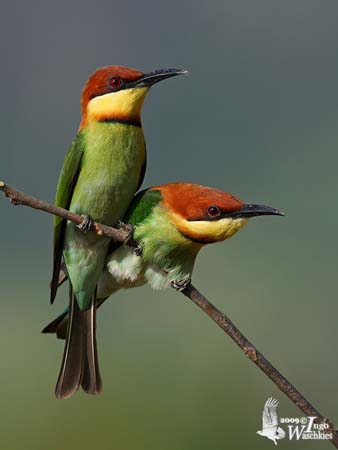
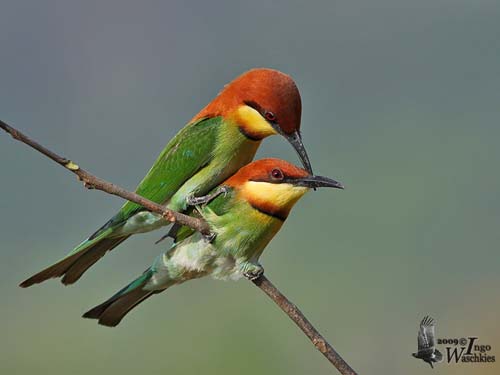
This species can breed in loose colonies with nests relatively close to each other, but single nests a few hundred metres apart may occur along roadsides or banks.
The Chestnut-headed Bee-eater is generally resident in its range, but there are marked migrations according to the region and rainfalls. They usually migrate by day.
This species, like all bee-eaters, is an accomplished strong flier and aerial hunter. It forages in continuous flight, performing wheeling and gliding flight on long pointed wings, fast twists and turns during chases and pursuits of preys.
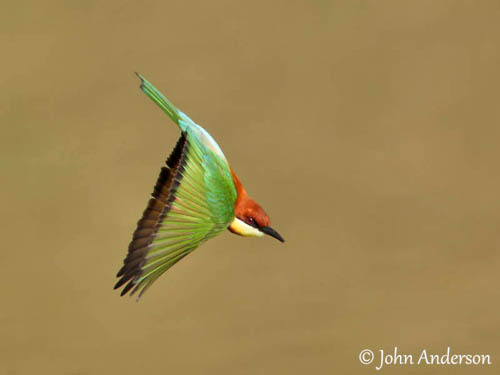
REPRODUCTION OF THIS SPECIES:
The laying occurs between February and June. The Chestnut-headed Bee-eater is loosely colonial with 10-100 nests in a colony, but it may also nest far from other pairs along a bank or a roadside.
Male and female excavate the burrow in flat, open, sandy ground, usually in sandbank or in vertical bank by river or road cutting. It also nests in high cliffs, with the nest-site near the top. The burrow is about 3-6 metres above ground or water.
The length of the burrow varies from 45 centimetres in hard earth, to 3 metres in soft soil. It may decline steeply or gently, from 25 to 50 centimetres below the surface and then, it becomes horizontal. Digging such nest may last almost one month.
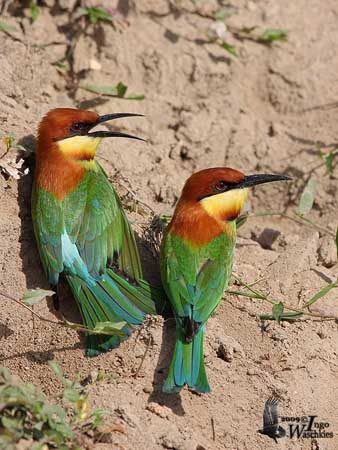
The female lays 4-8 white eggs and both sexes incubate, with shifts of 10-25 minutes.
Incubation and nestling period are unknown, but usually, incubation may last about 20 days, and the young fledge about 30 days after hatching. They probably still depend on parents for several days more.
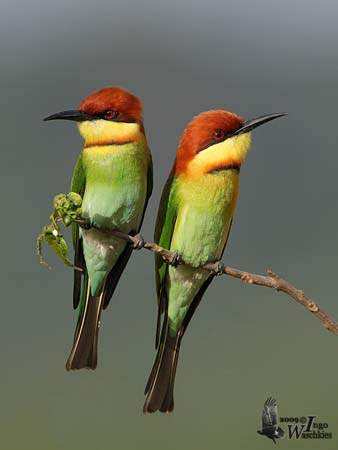
PROTECTION / THREATS / STATUS:
The Chestnut-headed Bee-eater is common locally throughout the wide range. Populations appear increasing and colonizing other areas. This species is present in several natural parks and reserves.
The Chestnut-headed Bee-eater is not currently threatened.
